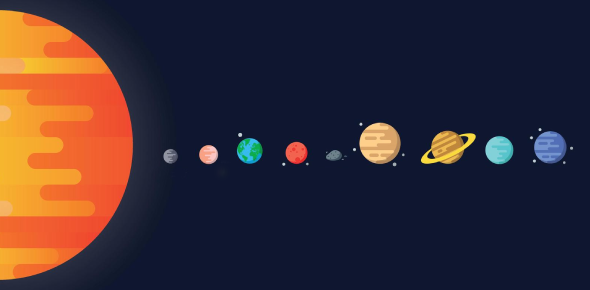Basic Science Quiz For Beginners

Are you ready to take this basic science quiz for beginners? This quiz is designed for you and anyone else who wants to test their knowledge about basic science facts. To ace this quiz, you may need to know facts and trivia about planets, the universe, scientific equipment, etc. Give this quiz a try, and remember to continue revising if you make errors.
Basic Science For Beginners Questions and Answers
- 1.
Which star is the closest to planet Earth?
- A.
Proxima Centauri
- B.
Sirius
- C.
Alpha Centauri
- D.
The Sun
Correct Answer
D. The SunExplanation
The Sun is the closest star to planet Earth, located approximately 93 million miles away. It is the center of our solar system and by far the most dominant source of energy for life on Earth. While other stars like Proxima Centauri and Sirius are significantly farther away, the Sun's proximity plays a crucial role in Earth's climate and ecosystem, making it the most influential star for our planet.Rate this question:
-
- 2.
Of all measurements, which speed is considered the fastest?
- A.
Speed of sound
- B.
Speed of light
- C.
Speed of Earth's rotation
- D.
All are equal
Correct Answer
B. Speed of lightExplanation
The speed of light in a vacuum is considered the fastest speed possible in the universe. It is a fundamental constant in physics and is approximately 299,792,458 meters per second. The speed of sound and the speed of Earth's rotation are significantly slower than the speed of light.Rate this question:
-
- 3.
What group of stars is the sun classified in?
- A.
Supernova
- B.
Hypernova
- C.
Yellow Dwarf
- D.
Red Supergiant
Correct Answer
C. Yellow DwarfExplanation
The Sun is classified as a G-type main-sequence star, also known as a yellow dwarf. This classification is based on its size, temperature, and luminosity. Yellow dwarfs are relatively small and have a surface temperature of around 5,500 degrees Celsius. They are the most common type of star in the Milky Way galaxy.Rate this question:
-
- 4.
Choose all the planets that are gas giants: (select all that apply)
- A.
Uranus
- B.
Neptune
- C.
Mars
- D.
Jupiter
- E.
Venus
- F.
Saturn
Correct Answer(s)
A. Uranus
B. Neptune
D. Jupiter
F. SaturnExplanation
Jupiter, Saturn, Uranus, and Neptune are gas giants characterized by their massive size and predominantly gaseous composition. These planets lack solid surfaces and are primarily composed of hydrogen and helium, with traces of other gases. Their immense gravitational pull compresses the gases into dense atmospheres surrounding small, rocky cores. Unlike terrestrial planets such as Mars and Venus, gas giants have extensive atmospheres and lack well-defined surfaces.Rate this question:
-
- 5.
Which scientist used one of the first telescopes to observe planets and stars?
- A.
Isaac Newton
- B.
Galileo Gallelli
- C.
James Watt
- D.
Roger Bacon
Correct Answer
B. Galileo GallelliExplanation
Galileo Galilei was an Italian astronomer and physicist who made significant contributions to the field of astronomy. He constructed his own telescope in 1609, which allowed him to make groundbreaking observations of celestial bodies and further our understanding of the universe. His findings revolutionized astronomy and laid the foundation for future scientific discoveries. Galileo was one of the scientists who proved the earth revolved around the sun.Rate this question:
-
- 6.
What are animals called that only consume other animals?
- A.
Omnivores
- B.
Herbivores
- C.
Carnivores
- D.
None of these
Correct Answer
C. CarnivoresExplanation
Carnivores are animals that only consume other animals for their diet. They are typically at the top of the food chain as secondary consumers. Carnivores often have specialized adaptations, such as sharp teeth and claws, to hunt and kill their prey. Unlike herbivores, which only consume plants, and omnivores, which consume both plants and animals, carnivores rely solely on animal meat for their nutritional needsRate this question:
-
- 7.
Which planet is the largest planet in our solar system?
- A.
Mars
- B.
Neptune
- C.
Jupiter
- D.
Earth
Correct Answer
C. JupiterExplanation
Jupiter is the largest planet in our solar system. It has a diameter of about 143,000 kilometers, making it more than 11 times the diameter of Earth. Jupiter's massive size is due to its high concentration of gasses, primarily hydrogen and helium. Its immense gravity also contributes to its size, allowing it to gather and hold onto a large amount of gas and other materials. Additionally, Jupiter has a strong magnetic field and numerous moons, further showcasing its dominance in our solar system.Rate this question:
-
- 8.
What is required for fire to burn?
- A.
Carbon
- B.
Oxygen
- C.
Nitrogen
- D.
None of these
Correct Answer
B. OxygenExplanation
Fire cannot burn without oxygen because oxygen is necessary for the process of combustion. When a fire burns, it undergoes a chemical reaction called oxidation, in which the fuel combines with oxygen to release heat and light. Without oxygen, there is no source of matter to react with the fuel, and therefore, the fire cannot sustain itself. Carbon usually reacts with oxygen in a combustion reaction but does not undergo that reaction if oxygen is not present.Rate this question:
-
- 9.
How many bones does an adult human usually have?
- A.
200
- B.
206
- C.
221
- D.
242
Correct Answer
B. 206Explanation
An adult human usually has 206 bones. Children actually have more than 206 bones, but some of their bones fuse together as they grow and become adults.Rate this question:
-
- 10.
Approximately how much time does light take to travel from Sun to Earth?
- A.
20 minutes
- B.
1 hour
- C.
8 minutes and 20 seconds
- D.
3 days
Correct Answer
C. 8 minutes and 20 secondsExplanation
Light takes approximately 8 minutes and 20 seconds to travel from the Sun to Earth. This is because light travels at a speed of about 299,792,458 kilometers per second, and the average distance between the Sun and Earth is about 149.6 million kilometers. By dividing the distance by the speed, we can calculate that it takes light roughly 500 seconds, or 8 minutes and 20 seconds, to reach Earth from the Sun.Rate this question:
-
- 11.
What is the most abundant gas in the Earth's atmosphere?
- A.
Oxygen
- B.
Hydrogen
- C.
Carbon Dioxide
- D.
Nitrogen
Correct Answer
D. NitrogenExplanation
Nitrogen makes up about 78% of the Earth's atmosphere, more than any other gas. Oxygen, the second most abundant, constitutes about 21%. This composition plays a crucial role in the sustainability of life on Earth, as nitrogen is essential for the synthesis of amino acids, which are the building blocks of proteins.Rate this question:
-
- 12.
What type of animal is a shark?
- A.
Mammal
- B.
Bird
- C.
Fish
- D.
Reptile
Correct Answer
C. FishExplanation
Sharks are a type of fish, characterized by their cartilaginous skeletons, five to seven gill slits on the sides of their heads, and pectoral fins that are not fused to the head. Known for their keen senses and predatory efficiency, sharks are an essential part of marine ecosystems and vary widely in size and shape.Rate this question:
-
- 13.
What is photosynthesis?
- A.
A process used by animals to consume food
- B.
A process plants use to convert sunlight into chemical energy
- C.
A method of water purification
- D.
A geological phenomenon
Correct Answer
B. A process plants use to convert sunlight into chemical energyExplanation
Photosynthesis is a vital biological process through which green plants, algae, and some bacteria convert light energy, usually from the sun, into chemical energy stored in glucose. It involves taking in carbon dioxide and water and releasing oxygen as a byproduct. This process is fundamental to life on Earth as it forms the base of most food chains.Rate this question:
-
- 14.
What is the hardest natural substance on Earth?
- A.
Diamond
- B.
Quartz
- C.
Gold
- D.
Iron
Correct Answer
A. DiamondExplanation
Diamond is renowned as the hardest natural substance found on Earth. Its unparalleled hardness and durability arise from the strong covalent bonding between the carbon atoms in a diamond's crystal structure. This characteristic makes diamonds highly valuable not only as gemstones but also industrially for cutting, grinding, and drilling other materials.Rate this question:
-
- 15.
What is the process called that converts a solid directly to a gas without passing through the liquid state?
- A.
Fusion
- B.
Sublimation
- C.
Deposition
- D.
Condensation
Correct Answer
B. SublimationExplanation
Sublimation is the phase transition in which a solid turns directly into a gas without first becoming a liquid. This process is observed under certain temperature and pressure conditions and is exemplified by dry ice, which is solid carbon dioxide that sublimates into carbon dioxide gas. Sublimation is a useful concept in various scientific fields, including meteorology, physics, and manufacturing.Rate this question:
-
Quiz Review Timeline +
Our quizzes are rigorously reviewed, monitored and continuously updated by our expert board to maintain accuracy, relevance, and timeliness.
-
Current Version
-
Oct 30, 2024Quiz Edited by
ProProfs Editorial Team
Expert Reviewed by
Daniel P -
May 11, 2012Quiz Created by
Saumik
- Aeronautics Quizzes
- Aerospace Quizzes
- Agricultural Science Quizzes
- Astrology Quizzes
- Astronomy Quizzes
- Atom Quizzes
- Biochemistry Quizzes
- Biology Quizzes
- Biomechanics Quizzes
- Biostatistics Quizzes
- Biotechnology Quizzes
- Botany Quizzes
- Branches Of Science Quizzes
- Chemistry Quizzes
- Cytology Quizzes
- Easy Science Quizzes
- Ecology Quizzes
- Electrical Quizzes
- Embryology Quizzes
- Endocrinology Quizzes
- Engineering Quizzes
- Environmental Science Quizzes
- Epidemiology Quizzes
- Experiment Quizzes
- Forestry Quizzes
- Fossil Quizzes
- Gas Quizzes
- General Science Quizzes
- Genetics Quizzes
- Histology Quizzes
- Human Biology Quizzes
- Integrated Science Quizzes
- Invention Quizzes
- Library Science Quizzes
- Lighting Quizzes
- Liquid Quizzes
- Marine Biology Quizzes
- Microbiology Quizzes
- Molecular Biology Quizzes
- Nature Quizzes
- Neuroscience Quizzes
- Nuclear Science Quizzes
- Oceanography Quizzes
- Physics Quizzes
- Psychology Quizzes
- Science And Technology Quizzes
- Science Glossary Quizzes
- Science Knowledge Quizzes
- Science Practice Quizzes
- Scientific Method Quizzes
- Scientific Notation Quizzes
- Soil Science Quizzes
- Solar System Quizzes
- Solid Quizzes
- Toxicology Quizzes
- Zoology Quizzes





(4).jpg)
.jpg)
(3).jpg)


.jpg)

(309).jpg)